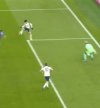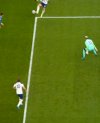
You are using an out of date browser. It may not display this or other websites correctly.
You should upgrade or use an alternative browser.
You should upgrade or use an alternative browser.
Tot vs cry
- Thread starter one
- Start date
socal lurker
RefChat Addict
The first touch, per Law 11 . . . yeah, I know that's not what you're asking.
As I have seen the actual work place for VARs (at least in the US), they aren't looking at a single feed at a time, but at multiple synced feeds. So this wouldn't be the angle they would use to determine when the ball first touched his foot. They'd choose an angle that gives the best view of when the first contact with the foot takes place and mark that frame. Then they would use that marked time to find the best angle to determine OSP.
As I have seen the actual work place for VARs (at least in the US), they aren't looking at a single feed at a time, but at multiple synced feeds. So this wouldn't be the angle they would use to determine when the ball first touched his foot. They'd choose an angle that gives the best view of when the first contact with the foot takes place and mark that frame. Then they would use that marked time to find the best angle to determine OSP.
one
RefChat Addict
I doubt this as the synching would only be required for VAR (or vertiual movement or whatever the name is used for it which I know EPL doesn't have). I'd imagine it would not deliver value for money to pay for.multiple synced feeds
In either case you have a reasonable angle in the first image to show 'first touch'. Or at the very lease to say that the next frame will not be the first touch. However they ended up using the second image.
Using the first image and the GA line as a guide, it shows offside.
Edit: just seen a third angle from behind the goal and the second image 'seems' to be more accurate. I am glad the AR call stood as I am still not convinced the tech used gives conclusive evidence on close calls to overrule and AR.
Last edited:
socal lurker
RefChat Addict
I doubt this as the synching would only be required for VAR
I suppose you can doubt anything you want (American politics certainly demonstrate that . . .), but MLS in fact has synced feeds in the VAR booth. The VAR can display up to four angles on the screen at the same time and move them forward and backwards together.
Peter Grove
RefChat Addict
According to an article on ESPN that went into great detail on how VAR actually works in practice in the Premier League, the VAR normally has a choice of three frames to use when deciding on which exact point in time to use for an offside decision.
I think there was a link on here to the article but I can't find it just now.
Anyway, since it has been estimated that a player moving at full speed can travel 20cm between frames that translates to a possible 40cm discrepancy between the first and last of the three frames they're looking at. That's quite a margin of error to be dealing with.
I think there was a link on here to the article but I can't find it just now.
Anyway, since it has been estimated that a player moving at full speed can travel 20cm between frames that translates to a possible 40cm discrepancy between the first and last of the three frames they're looking at. That's quite a margin of error to be dealing with.
So effectively the VAR on tight calls is unlikely to be "sure" whether a player is offside or not.According to an article on ESPN that went into great detail on how VAR actually works in practice in the Premier League, the VAR normally has a choice of three frames to use when deciding on which exact point in time to use for an offside decision.
I think there was a link on here to the article but I can't find it just now.
Anyway, since it has been estimated that a player moving at full speed can travel 20cm between frames that translates to a possible 40cm discrepancy between the first and last of the three frames they're looking at. That's quite a margin of error to be dealing with.
I can't be bothered checking - is it the edge of the ball nearest the goal line that is used to judge "level"?
ChasObserverRefDeveloper
Regular Contributor
No mention of "level" - was the attacker nearer the goal line than the ball when it was played is the question.
Peter Grove
RefChat Addict
Well, as @ChasTutorObserver says, they're looking at whether the player is closer to the goal line rather than level but yes, according to what I recall of the line-drawing when I've seen it taking place, the line is drawn from the edge of the ball closest to the goal line. Difficult to see how else it could be done though - drawing the line any other place would not show what it needs to show.So effectively the VAR on tight calls is unlikely to be "sure" whether a player is offside or not.
I can't be bothered checking - is it the edge of the ball nearest the goal line that is used to judge "level"?



